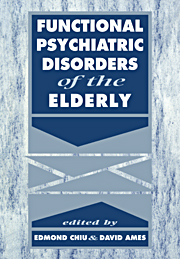Book contents
- Frontmatter
- Contents
- List of contributors
- Preface
- Introduction – A personal note
- Acknowledgement
- Part 1 Classification
- Part 2 General epidemiology
- 3 Epidemiology in the study of functional psychiatric disorders of the elderly
- Part 3 Neuroses
- Part 4 Affective disorders
- Part 5 Psychosexual disorders
- Part 6 Substance use and abuse
- Part 7 Schizophrenia and related psychoses
- Part 8 Psychological, biological and medical issues
- Part 9 Treatment methods
- Part 10 Conclusion
- Index
3 - Epidemiology in the study of functional psychiatric disorders of the elderly
from Part 2 - General epidemiology
Published online by Cambridge University Press: 13 November 2009
- Frontmatter
- Contents
- List of contributors
- Preface
- Introduction – A personal note
- Acknowledgement
- Part 1 Classification
- Part 2 General epidemiology
- 3 Epidemiology in the study of functional psychiatric disorders of the elderly
- Part 3 Neuroses
- Part 4 Affective disorders
- Part 5 Psychosexual disorders
- Part 6 Substance use and abuse
- Part 7 Schizophrenia and related psychoses
- Part 8 Psychological, biological and medical issues
- Part 9 Treatment methods
- Part 10 Conclusion
- Index
Summary
Introduction
This chapter deals with the contribution that epidemiology has made to our understanding of the functional psychiatric disorders in the elderly. To start with two terms should be defined. First, what is epidemiology? Descriptions range from the succinct ‘study of disease as a mass phenomenon’ by Greenwood (1934) to seven uses (Morris 1957) to five point definitions (Shepherd 1987). Practically speaking, nowadays, epidemiologists think in terms of four areas: rates of illness, correlates of caseness, risk factors and evaluating treatment and management. These can be addressed with relatively modest budgets and time frames. Other enterprises like longitudinal studies and field trials of new classifications, although fascinating, must be considered expensive and exceptional. Secondly, what does ‘functional’ mean? The Concise Oxford Dictionary (1982) defines functional in the case of mental illness as‘ having no discernable organic cause’. While modern textbooks do not attend to this definition, the Mayer-Gross, Slater and Roth textbook gave it two pages in 1969. There, ‘functional’ is used ‘to denote psychiatric disturbances unassociated with cerebral pathology or identifiable somatic disease’. There was thought to be relatively small overlap between ‘organic’ and ‘functional’. In the section on mental diseases of the aged, in the language of the day, the authors include manic-depressive disorder, chronic schizophrenia, late onset paraphrenia, neuroses and allied disorders and character disorders, including paranoid states.
The utility of epidemiology will be looked at through the perspectives of history, textbooks and recent publications.
- Type
- Chapter
- Information
- Functional Psychiatric Disorders of the Elderly , pp. 31 - 44Publisher: Cambridge University PressPrint publication year: 1994

